A Brief History, Plus How to Make Your Own
Jim Belcher
We didn’t know it at the time, but the 1950s were an era devoted to tackiness. Clothes, furniture, lifestyles … just about everything was tacky by today’s standards
Much of the 1950s aura has gone, and no one would think of duplicating it today. But there is one survivor which continues to hold promise for turning an otherwise charming interior or exterior into something which doesn’t quite work. I refer, of course, to TV antennae. Simple physics demands a certain size and shape which clashes quite elegantly with any decor you choose. It’s a potential which has been used quite broadly and naturally, yet seems to have escaped direct notice
This article will touch rather briefly on the basic requirements for a TV antenna, then discuss some of the landscape jarring units used in the past. Some current models with tacky potential will be discussed, and finally, the piece de resistance: an antenna you can make which will make you the subject of discussion and envy at the neighborhood block party
Viewed rather brutally, a TV antenna is really nothing but a big scoop to snatch the signal from an unsuspecting atmosphere. But the atmosphere has its revenge: the antenna can only be a certain size for a given TV channel or frequency. The higher the frequency, the smaller the antenna size. At higher frequencies, that means stacking up individual antennae of the correct size, to increase the amount of signal thus obtained. The resulting maze has the potential to destroy even the most serene of settings
 Outside Improvements Outside Improvements
Here is a text book* example of the sort of electronic fungus which was sprouting on rooftops in the early 1950s. What’s odd is that, green with envy for those who had a TV, no one seemed to notice how this changed the appearance of the postwar bungalows. This thing looks like the product of a wild night between a towel rack and a steam radiator. Yet it was accepted as the sign of a new age. One doesn’t see too many of this type of antenna these days
 A slightly more dramatic version is the little number shown at left. Of course, as the size increased, it gave an excuse to put up a tower to support the whole thing. The tower in itself added to the tacky aura, but provided an excellent excuse for its existence. A slightly more dramatic version is the little number shown at left. Of course, as the size increased, it gave an excuse to put up a tower to support the whole thing. The tower in itself added to the tacky aura, but provided an excellent excuse for its existence. One occasionally sees these antennae today, still serving their human masters. Consider the photo at right. Notice how the tower and antenna detract from the appearance of a charming dwelling. One occasionally sees these antennae today, still serving their human masters. Consider the photo at right. Notice how the tower and antenna detract from the appearance of a charming dwelling.
Interior Decor
But TV antennae weren’t limited to the exterior of dwellings. True, there was a limited amount of damage one could do to the appearance of a 1950s living room, but TV antennae could certainly do their part. If one lived in town, near the TV station, the standard TV antenna was the rabbit ears
 Rabbit ears: the name sounds cute, as though one was placing a little bunny rabbit in the room with your family. Of course, no rabbit ever had two foot, thin, aluminum ears. Nor did a rabbit ever cause ghost images to appear on your TV screen whenever a family member walked across the room. Or require that the length of its ears and the direction it was facing be changed whenever someone changed the TV channel. The constant physical activity associated with rabbit ears probably has much to do with the level of exercise and physical well-being of the American family of the 1950s. As a plus, the need to hop up and change the antenna slightly creates an additional level of tackiness in the presence of company. Normal conversation becomes impossible; the only thing which might have been more disruptive would have been for the thing to need regular trips outside for physical relief. Despite their popularity, rabbit ears were just as tacky technically as they were in appearance. The slender rods forming the ears really didn’t match the electrical needs of the set, turning and changing things just minimized the error Rabbit ears: the name sounds cute, as though one was placing a little bunny rabbit in the room with your family. Of course, no rabbit ever had two foot, thin, aluminum ears. Nor did a rabbit ever cause ghost images to appear on your TV screen whenever a family member walked across the room. Or require that the length of its ears and the direction it was facing be changed whenever someone changed the TV channel. The constant physical activity associated with rabbit ears probably has much to do with the level of exercise and physical well-being of the American family of the 1950s. As a plus, the need to hop up and change the antenna slightly creates an additional level of tackiness in the presence of company. Normal conversation becomes impossible; the only thing which might have been more disruptive would have been for the thing to need regular trips outside for physical relief. Despite their popularity, rabbit ears were just as tacky technically as they were in appearance. The slender rods forming the ears really didn’t match the electrical needs of the set, turning and changing things just minimized the error
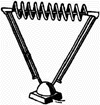 But if rabbit ears didn’t have quite the tacky effect one desired, there were other models available for set top use. The effects could be awe inspiring. Consider the drawing at left: this antenna appears to have started life as rabbit ears, but someone bent the rabbit’s ears, then stuck a hair curler over them. Did it work any better than regular rabbit ears? Probably not, but it looks impressive. If that wasn’t enough, there was the deluxe Frankenstein’s monster version But if rabbit ears didn’t have quite the tacky effect one desired, there were other models available for set top use. The effects could be awe inspiring. Consider the drawing at left: this antenna appears to have started life as rabbit ears, but someone bent the rabbit’s ears, then stuck a hair curler over them. Did it work any better than regular rabbit ears? Probably not, but it looks impressive. If that wasn’t enough, there was the deluxe Frankenstein’s monster version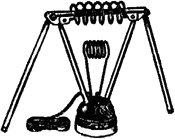 . This device looks impressive, but think how clashing it must have been amongst more civilized ornaments in the room! . This device looks impressive, but think how clashing it must have been amongst more civilized ornaments in the room!
Modern Interior Finishing Touches
If all thing sounds like an attempt to say we’ve come a long, long, way, nothing could be further from the truth. It is still possible buy antennae which look just as tacky, and in some cases work just as poorly. 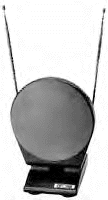 At left is a tacky little number, made, no doubt to look like a satellite antenna. Now, small dish satellite antennae work at a frequency something like 2,000 times that of UHF channels. There’s no way this shape is going to improve performance at regular TV frequencies, but think of the potential impact on your interior decor! If this antenna doesn’t clash sufficiently with whatever remains of the original decor of your room, consider the unit at right At left is a tacky little number, made, no doubt to look like a satellite antenna. Now, small dish satellite antennae work at a frequency something like 2,000 times that of UHF channels. There’s no way this shape is going to improve performance at regular TV frequencies, but think of the potential impact on your interior decor! If this antenna doesn’t clash sufficiently with whatever remains of the original decor of your room, consider the unit at right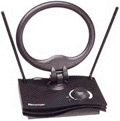 . It has a bit of the flavor of an old aircraft antenna, or perhaps a 1930’s vintage car steering wheel. In any event, it’s almost certain to clash with anything you may have . It has a bit of the flavor of an old aircraft antenna, or perhaps a 1930’s vintage car steering wheel. In any event, it’s almost certain to clash with anything you may have
None of these indoor antennae clash badly enough? There’s at least one more one might consider for extreme cases. This antenna mixes what little good taste remained in the pseudo-satellite dish version with other elements. 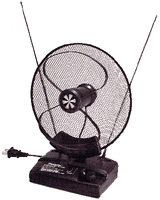 At first glance, it looks as though screen material may have been stolen from a screen door, or perhaps the protective grill from an old fan was added. The old fan motif is cleverly carried out with circular object in the middle which looks a little like a fan motor. It’s possible the figure eight may be meant to represent fan blades. In any event, the overall effect is ghastly, and looks totally out of place anywhere At first glance, it looks as though screen material may have been stolen from a screen door, or perhaps the protective grill from an old fan was added. The old fan motif is cleverly carried out with circular object in the middle which looks a little like a fan motor. It’s possible the figure eight may be meant to represent fan blades. In any event, the overall effect is ghastly, and looks totally out of place anywhere
Incidentally, all of the current TV antennae shown have been offered recently on eBay. If you’re looking for a place to pick up things which add that special tacky touch, it has real possibilities
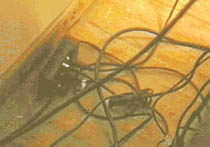 Many of the current antennae have built in amplifiers. Frankly, one can’t amplify signal that isn’t there, and these amplifiers are hidden within the antenna, so they do little to detract from the appearance of a room. However, separate amplifiers can have value if they are sufficiently bulky, and have enough wires dangling from them. Any well-decorated room can be transformed into a tacky maze of wires with a little effort. Consider the example at right: a TV amplifier being used to drive a TV, a separate TV receiver, an FM tuner, and a VCR. As a bonus, the extra power and signal wiring this adds can be a real asset in destroying any semblance of order the room might have had. A really tacky household should consider adding equipment like this even if it isn’t really needed Many of the current antennae have built in amplifiers. Frankly, one can’t amplify signal that isn’t there, and these amplifiers are hidden within the antenna, so they do little to detract from the appearance of a room. However, separate amplifiers can have value if they are sufficiently bulky, and have enough wires dangling from them. Any well-decorated room can be transformed into a tacky maze of wires with a little effort. Consider the example at right: a TV amplifier being used to drive a TV, a separate TV receiver, an FM tuner, and a VCR. As a bonus, the extra power and signal wiring this adds can be a real asset in destroying any semblance of order the room might have had. A really tacky household should consider adding equipment like this even if it isn’t really needed
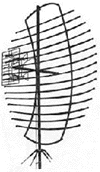 Modern Exterior Touches Modern Exterior Touches
It’s still possible to dress down the exterior of one’s house. Some of the newer antennae aren’t as messy as the older designs, but that can be countered by installing multiple antennae. There are a few designs, however, that can detract from anything. At right is an ultra high gain UHF antenna that can destroy the exterior appearance of something as lowly as a warehouse. It may look innocent, but this antenna measures seven feet in diameter! The sheer size alone offsets anything in the general vicinity
An Antenna You Can Build
The antenna described here is fairly simple to build, but can contribute greatly to the demise of the decor of any room. The antenna can be built to receive VHF TV or FM stations. It has about the same ability to receive signals as a pair of rabbit ears; this can be improved slightly by mounting the antenna outside. Both the inside and outside versions will be described, although both start with the same basic construction
One obtains a coil of TV twin lead from an electronics store, a soldering iron, and some solder. Twin lead has two wires in it, one on either side. Cut a piece of the twin lead twice the value of D (from the table), plus an inch. Strip half an inch of the insulation from both ends of the twin lead. This will expose two wires. Twist the wires together, and solder them (Figure 1, Figure 2). Cut one of the sides of the twinlead at the center point, leaving one wire exposed on either side of the center. Strip about half an inch of insulation from each exposed wire. Set this aside for the moment. From the larger piece of twin lead originally purchased, strip half an inch of insulation from each of the wires on one end. Twist each of the wires to one of the wires in the center of the piece previously prepared (Figure 3), and solder the joint. The “T” shaped piece is the actual antenna. The twin lead running away from the antenna is connected to the receiver (300 ohm input). Cut this lead to length on installation. This antenna can be dumped on the floor in a semi-hidden place, or perhaps stapled to a wall in a more visible location. It all depends on the effect one wishes to achieve
The Exterior Version
If this antenna doesn’t produce quite enough signal, or one wishes an exterior effect, the antenna can be mounted to a support (Figure 4). The support can be made from wood dowel, or a similar non-conducting material. PVC water pipe is a good choice. Half-inch PVC is sturdy enough for the purpose, but 3/4″ or 1″ will work just as well. 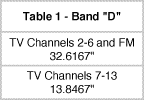 Cut two pieces of the PVC to the length “D”, from table 1. Cement them to either side of a PVC “T”. Cut one longer length of PVC pipe to whatever length is needed to support and elevate the assembly. Cement it to the center of the “T”. If one wishes, PVC caps may be added to the open ends of the pipe. However, leaving the pipe ends open adds the possibility that some manner of interesting creature may nest therein, adding to the overall effect. Tape the twin lead antenna previously manufactured to the support with black electrical tape (Figure 5). Other kinds of tape will work as well, but be sure to use nonmetallic tape. Mount the assembly by the pipe attached to the center section, with the broad side facing the broadcasting station (Figure 6). Antenna clamps are available achieve this, but bent nails work quite well, and add to the overall effect. If this doesn’t suffice, leftover Christmas wrapping tape may be applied to add to the overall effect (Figure 7). Once again, be certain not to use tape containing metal. Enjoy your antenna! Cut two pieces of the PVC to the length “D”, from table 1. Cement them to either side of a PVC “T”. Cut one longer length of PVC pipe to whatever length is needed to support and elevate the assembly. Cement it to the center of the “T”. If one wishes, PVC caps may be added to the open ends of the pipe. However, leaving the pipe ends open adds the possibility that some manner of interesting creature may nest therein, adding to the overall effect. Tape the twin lead antenna previously manufactured to the support with black electrical tape (Figure 5). Other kinds of tape will work as well, but be sure to use nonmetallic tape. Mount the assembly by the pipe attached to the center section, with the broad side facing the broadcasting station (Figure 6). Antenna clamps are available achieve this, but bent nails work quite well, and add to the overall effect. If this doesn’t suffice, leftover Christmas wrapping tape may be applied to add to the overall effect (Figure 7). Once again, be certain not to use tape containing metal. Enjoy your antenna!
*And well it should be, because I swiped this drawing directly from the text book I had in an engineering course. |



 One occasionally sees these antennae today, still serving their human masters. Consider the photo at right. Notice how the tower and antenna detract from the appearance of a charming dwelling.
One occasionally sees these antennae today, still serving their human masters. Consider the photo at right. Notice how the tower and antenna detract from the appearance of a charming dwelling.

 . This device looks impressive, but think how clashing it must have been amongst more civilized ornaments in the room!
. This device looks impressive, but think how clashing it must have been amongst more civilized ornaments in the room!  At left is a tacky little number, made, no doubt to look like a satellite antenna. Now, small dish satellite antennae work at a frequency something like 2,000 times that of UHF channels. There’s no way this shape is going to improve performance at regular TV frequencies, but think of the potential impact on your interior decor! If this antenna doesn’t clash sufficiently with whatever remains of the original decor of your room, consider the unit at right
At left is a tacky little number, made, no doubt to look like a satellite antenna. Now, small dish satellite antennae work at a frequency something like 2,000 times that of UHF channels. There’s no way this shape is going to improve performance at regular TV frequencies, but think of the potential impact on your interior decor! If this antenna doesn’t clash sufficiently with whatever remains of the original decor of your room, consider the unit at right . It has a bit of the flavor of an old aircraft antenna, or perhaps a 1930’s vintage car steering wheel. In any event, it’s almost certain to clash with anything you may have
. It has a bit of the flavor of an old aircraft antenna, or perhaps a 1930’s vintage car steering wheel. In any event, it’s almost certain to clash with anything you may have At first glance, it looks as though screen material may have been stolen from a screen door, or perhaps the protective grill from an old fan was added. The old fan motif is cleverly carried out with circular object in the middle which looks a little like a fan motor. It’s possible the figure eight may be meant to represent fan blades. In any event, the overall effect is ghastly, and looks totally out of place anywhere
At first glance, it looks as though screen material may have been stolen from a screen door, or perhaps the protective grill from an old fan was added. The old fan motif is cleverly carried out with circular object in the middle which looks a little like a fan motor. It’s possible the figure eight may be meant to represent fan blades. In any event, the overall effect is ghastly, and looks totally out of place anywhere Many of the current antennae have built in amplifiers. Frankly, one can’t amplify signal that isn’t there, and these amplifiers are hidden within the antenna, so they do little to detract from the appearance of a room. However, separate amplifiers can have value if they are sufficiently bulky, and have enough wires dangling from them. Any well-decorated room can be transformed into a tacky maze of wires with a little effort. Consider the example at right: a TV amplifier being used to drive a TV, a separate TV receiver, an FM tuner, and a VCR. As a bonus, the extra power and signal wiring this adds can be a real asset in destroying any semblance of order the room might have had. A really tacky household should consider adding equipment like this even if it isn’t really needed
Many of the current antennae have built in amplifiers. Frankly, one can’t amplify signal that isn’t there, and these amplifiers are hidden within the antenna, so they do little to detract from the appearance of a room. However, separate amplifiers can have value if they are sufficiently bulky, and have enough wires dangling from them. Any well-decorated room can be transformed into a tacky maze of wires with a little effort. Consider the example at right: a TV amplifier being used to drive a TV, a separate TV receiver, an FM tuner, and a VCR. As a bonus, the extra power and signal wiring this adds can be a real asset in destroying any semblance of order the room might have had. A really tacky household should consider adding equipment like this even if it isn’t really needed
 Cut two pieces of the PVC to the length “D”, from table 1. Cement them to either side of a PVC “T”. Cut one longer length of PVC pipe to whatever length is needed to support and elevate the assembly. Cement it to the center of the “T”. If one wishes, PVC caps may be added to the open ends of the pipe. However, leaving the pipe ends open adds the possibility that some manner of interesting creature may nest therein, adding to the overall effect. Tape the twin lead antenna previously manufactured to the support with black electrical tape
Cut two pieces of the PVC to the length “D”, from table 1. Cement them to either side of a PVC “T”. Cut one longer length of PVC pipe to whatever length is needed to support and elevate the assembly. Cement it to the center of the “T”. If one wishes, PVC caps may be added to the open ends of the pipe. However, leaving the pipe ends open adds the possibility that some manner of interesting creature may nest therein, adding to the overall effect. Tape the twin lead antenna previously manufactured to the support with black electrical tape 



